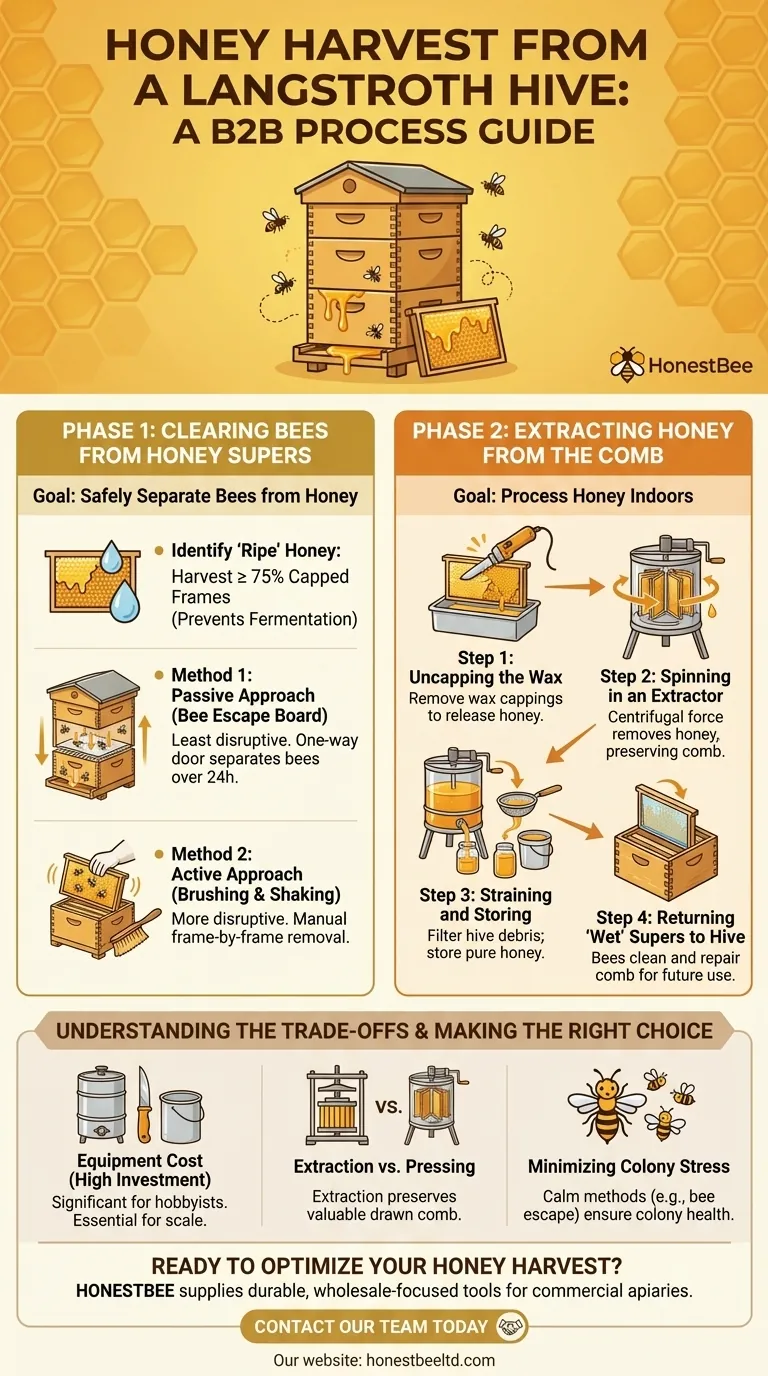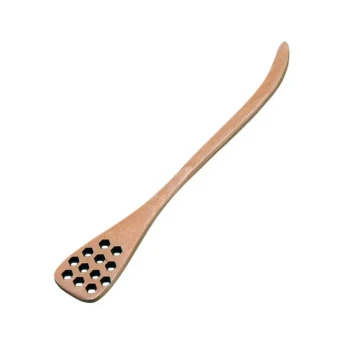Harvesting honey from a Langstroth hive is a two-phase process that begins inside the apiary and concludes in a dedicated processing space. First, you must safely and calmly separate the bees from the honey-filled boxes (supers), and second, you must extract that honey from the wax combs for bottling and storage.
The core principle of a successful harvest is to remove the bees' surplus honey with minimal disruption to the colony. This is best achieved using a passive method like a bee escape board, followed by mechanical extraction, which preserves the delicate comb for the bees to reuse.

Phase 1: Clearing Bees from the Honey Supers
Before you can take the honey, you must move the bees out of the way. Your goal is to remove the honey supers, which are the boxes on top of the hive, leaving the bees with their own food stores in the lower brood chamber.
Know When to Harvest: Identifying 'Ripe' Honey
The first step is ensuring the honey is ready. Bees cap honey with a layer of fresh wax only when its moisture content is low enough (around 18%) to prevent fermentation.
Harvest frames that are at least three-quarters capped. Harvesting uncapped honey can lead to spoilage unless you have a refractometer to verify its water content.
Method 1: The Passive Approach (Bee Escape Board)
This is the calmest and least disruptive method for the bees. A bee escape board, also called a clearer board, is a one-way door placed between the honey supers you want to harvest and the brood boxes below.
Bees can travel down through the escape into the main hive but cannot find their way back up. Place the board on the hive in the morning and return the following morning to find the honey supers nearly empty of bees, ready for removal.
Method 2: The Active Approach (Brushing and Shaking)
This manual method requires no special equipment beyond a bee brush, but it is more disruptive to the colony.
You work frame by frame, removing a frame of honey from the super, holding it over the open hive, and giving it a sharp shake to dislodge most of the bees. Any remaining bees can be gently swept off with a bee brush.
Phase 2: Extracting Honey from the Comb
Once you have your bee-free frames of honey, you must move to a clean, indoor space (away from bees) to process them. This phase requires specialized equipment.
Step 1: Uncapping the Wax
The wax cappings must be removed to release the honey. This is typically done with a heated uncapping knife or a specialized fork.
As you slice off the thin wax layer, let the cappings fall into a tub or a dedicated capping tank. These wax cappings are saturated with honey and can be strained later.
Step 2: Spinning in an Extractor
An extractor is a drum that uses centrifugal force to sling honey out of the comb without destroying it.
Place the uncapped frames into the baskets inside the extractor. Spin the frames for several minutes until the honey is slung from the first side. Then, flip the frames and spin again to extract honey from the other side.
Step 3: Straining and Storing
Open the gate at the bottom of the extractor to let the honey flow out. The raw honey should be poured through a strainer or filter to remove any bits of wax or other hive debris.
Once strained, the pure, clean honey is ready to be stored in food-grade buckets or bottled for use.
Step 4: Returning 'Wet' Supers to the Hive
The frames, now empty of honey but still sticky, are called "wet" supers. Returning these to the hive is a critical final step.
The bees will quickly clean every last drop of honey and repair any damaged comb. This practice prevents honey from attracting pests or inciting robbing behavior from other hives, and it gives your bees a significant head start on the next honey flow.
Understanding the Trade-offs
Harvesting is a balance of efficiency, cost, and colony health. Your chosen method reflects your priorities as a beekeeper.
The Cost of Equipment
The primary tools for this process—an extractor, an uncapping tank, and a hot knife—are expensive. They are also used for only a very short period each year, representing a significant investment for a hobbyist.
Extraction vs. Pressing
The Langstroth system is designed around extraction specifically to preserve the drawn comb. While a honey press can also separate honey from wax, it destroys the comb in the process. Bees expend enormous energy to build comb, so preserving it allows them to be far more productive.
Minimizing Colony Stress
Every interaction with the hive causes some level of stress. The bee escape board method is far superior to the brush-and-shake method in this regard. A calm harvest ensures the queen continues laying and the colony's defensive behavior is not triggered.
Making the Right Choice for Your Goal
Your approach to harvesting should align with your scale and beekeeping philosophy.
- If your primary focus is minimizing bee stress and promoting a calm apiary: Use a bee escape board one day prior to your harvest.
- If you have only one hive and want to minimize initial costs: The manual brush-and-shake method is effective, though more labor-intensive and disruptive.
- If your primary focus is long-term efficiency and honey yield: Investing in a honey extractor is non-negotiable, as it preserves the bees' most valuable resource: their wax comb.
Ultimately, a successful harvest is the rewarding result of a well-managed colony and a thoughtful, methodical process.
Summary Table:
| Phase | Key Step | Purpose/Goal |
|---|---|---|
| 1. Clearing Bees | Use a Bee Escape Board or Brushing/Shaking | Safely remove bees from honey supers with minimal colony disruption. |
| 2. Extraction | Uncapping, Spinning, Straining | Release, collect, and purify honey from the wax comb for storage. |
| Post-Harvest | Return 'Wet' Supers to Hive | Allow bees to clean frames and repair comb, boosting future productivity. |
Ready to optimize your honey harvest?
A smooth, efficient harvest relies on high-quality equipment. HONESTBEE supplies commercial apiaries and beekeeping equipment distributors with the durable, wholesale-focused tools you need for success—from bee escape boards and extractors to uncapping knives and strainers.
Let's discuss your operation's needs. Contact our team today to learn how our products can help you maximize honey yield while maintaining a healthy, productive colony.
Visual Guide

Related Products
- 10L Stainless Steel Electric Honey Press Machine
- Stainless Steel Honey Press Wax Press with Tank
- Stainless Steel Manual Honey Press with Guard for Pressing Honey and Wax
- Electric Flatting and Embossing Machine with Tray for Beekeeping
- Honey Wax Separating Wax Press with Metal Screw Wax Separator Machine
People Also Ask
- What are the benefits of the screw design in a stainless steel honey pump? Preserve Honey Quality and Integrity
- What are the key features of a honey press? Maximize Yield with Durable, Efficient Extraction
- What are the benefits of using a honey press for Warré or Top Bar beehives? Maximize Your Natural Harvest
- What are the key features of the stainless steel honey press? Maximize Yield & Guarantee Purity
- What are the main differences between centrifugal extractors and honey presses? A Guide for Commercial Apiaries



















